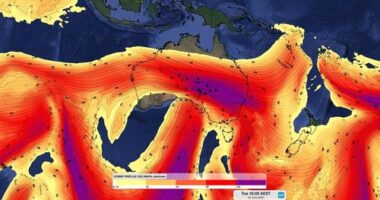A nuclear war could have catastrophic consequences and spread radiation globally. Investigative journalist Annie Jacobsen suggested that in the event of World War III, Americans should consider seeking refuge in Australia or New Zealand. These neighboring countries in the Southern Hemisphere may be the only places capable of sustaining agriculture after a nuclear disaster in the northern hemisphere.

With ongoing tensions in the Middle East, concerns about potential Iranian sleeper cells in the US have raised alarm about the possibility of a mass destruction event. Ceasefire negotiations between Iran and Israel have stalled, each side accusing the other of breaching a fragile truce. Nuclear superpowers like Russia and China, aligned with Iran, have cautioned that US intervention in the Middle East conflict could escalate into a global war, potentially leading to catastrophic consequences.

Jacobsen painted a bleak picture of a post-nuclear war world during a podcast with host Steven Bartlett. She described how regions like Iowa and Ukraine could be covered in snow for a decade, leading to agricultural collapse and mass starvation. Additionally, the damaged ozone layer would result in radiation poisoning, making it unsafe for people to be exposed to sunlight. These chilling predictions underscore the dire effects of a nuclear conflict on humanity and the planet.

‘People will be forced to live underground. So you have to imagine people living underground, fighting for food everywhere except for in New Zealand and Australia,’ she continued. Before the crisis in the Middle East even escalated, Jacobsen had released a book entitled Nuclear War: A Scenario, which laid out in shocking detail how the end of the world would play out during World War III. ‘Hundreds of millions of people die in the fireballs, no question,’ she told Bartlett.
![However, Jacobsen added that a 2022 study by Professor Owen Toon in Nature Food claimed the death toll would quickly consume the majority of the world's population. 'Professor Toon and his team... sort of updated [the] nuclear winter idea based around food, and the number that they have is five billion people would be dead,' Jacobsen said. Nuclear winter describes the severe, long-lasting global cooling that could happen after a large-scale nuclear war.](https://i.dailymail.co.uk/1s/2025/06/24/19/99542119-14843437-However_Jacobsen_added_that_a_2022_study_by_Professor_Owen_Toon_-a-296_1750788691960.jpg)
However, Jacobsen added that a 2022 study by Professor Owen Toon in Nature Food claimed the death toll would quickly consume the majority of the world’s population. ‘Professor Toon and his team… sort of updated [the] nuclear winter idea based around food, and the number that they have is five billion people would be dead,’ Jacobsen said. Nuclear winter describes the severe, long-lasting global cooling that could happen after a large-scale nuclear war.

In a full-scale war, where many cities are hit by nuclear bombs, those explosions would cause huge fires, burning buildings, forests, and other structures. The smoke and soot from these fires would rise high into the sky, into a part of the atmosphere called the stratosphere, where it can stay for years because rain can’t wash it away. This thick layer of soot would block sunlight from reaching the Earth’s surface, like a giant shade over the planet.

With less sunlight, the Earth would get much colder. The experts Jacobsen spoke to in her book predicted that temperatures in the US would plunge by roughly 40 degrees Fahrenheit, making farming impossible. This cold and darkness would lead to massive food shortages and starvation. Animals and fish would also struggle to survive, making food even scarcer. ‘The population of the planet currently is what, eight billion?’ Bartlett said. ‘So there’d be three billion people still alive. Where shall I go to be one of the three billion? I was just in New Zealand and Australia,’ the host mentioned.

‘That’s exactly where you’d go. According to Toon, those are the only places that could actually sustain agriculture,’ Jacobsen replied. Along with both nations being capable of producing food once the dust settles on a nuclear war , Australia and New Zealand have several other factors which make this part of the world a haven from global destruction. They are far from the major nuclear powers which would likely spark a world war, the US, Russia, and China.

Being island nations, their isolation in the Pacific and Southern Oceans limits fallout from nuclear detonations up north. That’s because prevailing winds and ocean currents would carry much of the radioactive material away from these regions. For those who can’t afford a trip to Australia or New Zealand, the renewed threat of a global nuclear war has sparked a nationwide search to locate America’s long-forgotten fallout shelters.

Although they’re not built to withstand the initial blast, extreme heat, and shockwaves of a nuclear explosion, they can act as a safe room for anyone who lives to see the aftermath. As for what makes a good fallout shelter, shielding is the most important factor. Thick walls and a roof made of concrete or steel are necessary to block out the radiation produced by a nuclear explosion. Fallout shelters also need good ventilation with proper filters to trap radioactive particles in the air. Those inside will need enough food and clean water to last for weeks or months as the radiation clears the air, an area for waste disposal so you don’t contaminate clean supplies, and a comfortable place to sit or sleep.









